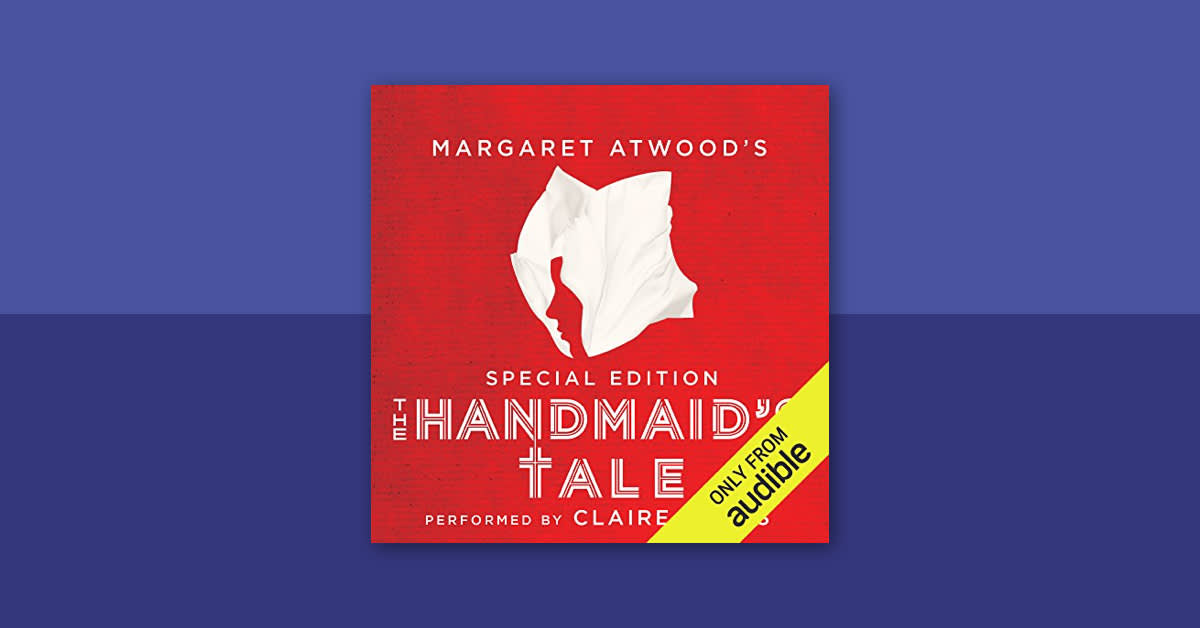The Handmaid's Tale by award-winning Canadian author Margaret Atwood was first published in 1985, and has been haunting readers and listeners ever since. This chilling work of fiction depicts a future totalitarian state in which women are completely subjugated, while offering incisive commentary on patriarchy, reproductive justice, misogyny, religious fanaticism, and fascism. The Handmaid's Tale was adapted for television in 2017, and the Hulu series has sparked a renewed interest in the now classic dystopian novel. But is the popular TV show true to Atwood's original vision?
Warning: The following article contains spoilers for The Handmaid’s Tale.
Where is The Handmaid’s Tale set?
The Handmaid's Tale is set in New England in the not-too-distant future, within a patriarchal, fundamentalist, totalitarian state known as the Republic of Gilead. The United States government has collapsed, and Gilead has risen up in its place. Under the new regime, women are not allowed to have careers, own property, or handle money. And they have no reproductive rights. Because pollution has made so many women barren, young fertile women are classified as "Handmaids" and forced to bear children for the wealthy ruling class of men.
What is The Handmaid’s Tale about?
The novel is narrated in the first person by Offred, a Handmaid who is assigned to a man known only as the Commander. Offred recounts the events of her life in Gilead, beginning with her assignment to the Commander. In flashbacks, she also shares the details of her life before Gilead and in the early days of its oppressive rule, recalling how she attempted to flee to Canada with her husband and child, the time she spent being "trained" as a Handmaid, and her best friend's escape from the training facility. The novel explores the many challenges Offred faces in her role as a Handmaid and details the various horrors that make up everyday life in Gilead. She eventually learns of a secret resistance movement working to bring down the government, but it's left unclear whether she is able to make contact with them at the end of the book. The novel closes with Offred being taken away from the Commander's house by men in government cars, leaving listeners to wonder whether her captors are secret police or members of the resistance.
What are the differences between The Handmaid’s Tale book and movie?
The first season of the show remains mostly true to the events of the novel. With a few tweaks, it follows roughly the same timeline. Most of the characters bear a strong resemblance to their counterparts in the book, though there are a few important differences (as you'll see below). The show also stays true to the horrors that Atwood describes—even, in some cases, amplifying them.
Despite the general similarities, there are a number of differences between The Handmaid's Tale TV series and the novel. What are the major variations? Does the show make any significant changes to the plot? What liberties did the showrunners take with the source material? We'll take a look at how the characters in the show stack up to those in the book, and we'll also delve into some of the small but crucial differences in the show's timeline, events, and world-building.
The Handmaid’s Tale Characters: Book vs. Show
Offred/June
Offred is the protagonist of both the novel and the show. She narrates the book in the first person, and often provides voiceover monologues in the TV series. And while the show stays fairly true to Atwood's original characterization of Offred, there are some differences. Here are the big ones:
Her name: In the book, we never learn Offred's real name. Like all Handmaids, she is given a name derived from the man she is assigned to bear children for—Offred is literally "Of Fred." In the show, her true name, June, is revealed in the first episode.
Pre-Gilead Protests: In the book, Offred does reflect on life in the US before Gilead. She recalls the protests that erupted after women were barred from working and owning property. But she never participated in these protests, fearing for the lives of her husband and daughter. In the show, however, June is an active participant in the protests. Season one includes a flashback to June and her friend Moira at a protest that turns violent when officials begin firing into the crowd.
Her rebelliousness: In the book, Offred is a lot less rebellious. She refuses to participate in pre-Gilead protests, and later, she refuses to spy on the Commander when Ofglen asks her to. She's mostly concerned with surviving, and though she narrates events as they unfold, she doesn't always try to change them. In the show, she's a lot more fiery. Her internal monologues reveal her anger and dissatisfaction, and her desire to do something about it.
Her mother: In the book, Offred's mother is a women's rights activist who participated in the women's liberation movements of the 1960s and 1970s. She didn't think that June truly appreciated the sacrifices her generation had made, and this caused tension between them. Offred's mother doesn't appear at all in the show.
Luke and June's affair: In both the book and the show, adultery and divorce are illegal in Gilead; this is why June and Luke initially attempt to flee to Canada. In the book, we learn that Luke cheated on his wife with June, but that's about it. The show, however, includes several flashbacks that shed light on the beginning of their relationship, going into much more depth than the book ever does.
Her pregnancy: In the show, after learning that Offred went to Jezebel's with the Commander, Serena Joy forces her to take a pregnancy test, which comes out positive. There is no pregnancy test in the novel; Offred believes she is pregnant, but it is never confirmed.
The Commander/Fred
His name: In the book, the Commander's last name is never revealed. We know his first name is Fred because of the name his Handmaid is given, but that's it. In the show, we learn his full name: Fred Waterford. He also appears younger and more conventionally attractive on the show; in the book, he's described as an older man.
His role: In the book, we don't learn much about the Commander or his role in the government. The show makes it clear that he is not only a powerful man in present-day Gilead, but that he was instrumental in the nation's creation.
Serena Joy
Her age: Serena Joy is much older in the book than she is in the show.
Her past career: In the book, Offred recognizes Serena Joy because she used to appear on Christian TV channels. In the show, she was once a famous author, not a TV personality.
Her involvement with Gilead's formation: In the book, Serena Joy is briefly described as a former religious TV personality who advocated for "traditional family values," encouraging women to stay home rather than work outside it. In the show, her backstory is much more fleshed out. Several flashbacks show Serena Joy and Fred during the formation and early days of Gilead, illustrating her deep involvement in many of the government's beliefs and policies.
Ofglen
Her backstory: In the book, Ofglen's backstory is vague; we learn almost nothing about her. Her backstory in the show is much more extensive. We learn her real name is Emily, and she had a wife and son, who managed to escape to Canada, before Gilead.
Her role in the present: Ofglen is a relatively minor character in the book. She is Offred's shopping partner and is involved in the resistance. She disappears one day, and Offred never learns what happens to her. The Handmaid who replaces her reports that the original Ofglen killed herself when she learned of her arrest—though there's no way for Offred to determine if this is true. In the show, we learn what happens to Ofglen after she disappears from Offred's life. She is arrested, not for her role in the resistance but because she had an affair with a Martha. The woman she slept with is hanged, but Ofglen is pardoned due to her fertility. However, she is then circumcised as punishment for her transgressions. Her story doesn't end with this atrocity. In season two, Ofglen is sent to the Colonies and later escapes to freedom in Canada.
Aunt Lydia
Her backstory: The show gives Aunt Lydia a much more detailed backstory that the novel does. In the show, we learn she used to be a teacher with strict Christian family values. In season three, there's a flashback showing her calling Child Protective Services on a young mother, who ends up losing her son because of it. In the book, although she's still portrayed as religious and loyal to Gilead, we don't get the same level of detail about her past life, only that she used to be a lawyer.
Appearances: In the book, Aunt Lydia only appears in flashback scenes, when Offred is remembering her time at the Red Center. In the show, she has a much larger role, and Offred encounters her several times in the present.
Luke
Luke and June's attempted escape: In the book, we don't learn about June and Luke's flight from Gilead until fairly late in the action. But the show begins with a flashback showing June, Luke, and their daughter, Hannah, attempting to cross into Canada. June is in front with Hannah and hears gunshots behind her. The implication is that Luke has died. In the show, most of June's hope is pinned on finding her daughter again, because she assumes Luke is dead. In the book, she also holds out hope that one day she might be reunited with Luke.
Luke's status: In the book, though Offred hopes that Luke has survived, his life or death is never confirmed. In the show, it is eventually revealed that Luke is, indeed, alive and well. He managed to successfully escape to Canada, where he began a new life.
Moira
Her appearances: In both the book and the show, Moira and Offred are good friends pre-Gilead. They also meet again in the same way in both the book and the show: Offred accompanies the Commander to an underground club, Jezebel's, where Offred encounters Moira. In the book, Moira appears to be totally resigned to her new life, no longer the fiery, independent woman that Offred once knew. Offred leaves Jezebel's and never sees Moira again. On the show, however, seeing Offred reenergizes Moira. Offred gives her some encouragement and inspiration. Later, Moira manages to escape to Canada, where she eventually meets up with Luke.
Nick
Relationship with Offred: In both the book and the show, Nick and Offred began a sexual relationship at the urging of Serena Joy, to help improve Offred's chances of getting pregnant. But Nick's true feelings and motivations are somewhat vague in the book. We never learn if he's an Eye for the government (as Offred originally suspects) or a part of the resistance. He doesn't have a backstory to speak of. In the show, he gets much more screen time, including several flashbacks that give some insight into his life pre-Gilead. He's portrayed as a man who's truly in love with Offred, despite the impossibility of their situation.
Ofwarren/Janine
Her backstory and behavior at the Red Center: In the book, Janine is not especially rebellious and doesn't cause much trouble at the Red Center. Instead, she's compliant and does as she's told; the Aunts actually ask her to spy on the other girls. In the show, however, Janine rebels against the Aunts; as punishment, they remove her eye.
Her storyline: Janine is a relatively minor character in the book. She gives birth to a baby girl for Warren and his wife. Offred sees her once later in the book, but that's about all we learn about Janine. In the show, she has a much more complex storyline. After she gives birth, she runs away with the baby and tries to jump off a bridge. Offred talks her down.
The Handmaid’s Tale Book vs. Show: World-building
Technology Updates
Atwood's novel was published in the 1980s, before the advent of smartphones and other modern technology, and it's set in an unspecified near-future. The show, which is meant to take place in the present, includes references to everyday devices, technologies, and other facts of modern life that help place it in the 21st century. Characters use smartphones and make references to apps and sites like Uber and Craigslist. Additionally, instead of ankle tattoos, all the Handmaids have small electronic GPS trackers installed in their ears.
Diversity
In the book, there are no characters of color, major or minor. This is explicitly explained and attributed to Gilead's overt racism. Atwood describes how, shortly after the founding of Gilead, Black people were rounded up and "resettled" in an undisclosed location. Though the book doesn't make specific references to other non-white people, it is understood that Gilead is a white supremacist society, and, therefore, white-only by design.
In the show, while Gilead is still clearly depicted as a racist society—as evidence, all of the high-ranking men are white—there are plenty of non-white characters, including June's husband, Luke, and friend Moira, who are both Black. The cast also includes several Handmaids who are women of color.
The Colonies
Though the Colonies are mentioned in the book, we learn very little about them. They are described as work camps where criminals, Handmaids who have failed to conceive, feminists, and other agitators are sent to do hard labor and die. No major characters are sent there, so we never learn what the Colonies are actually like. In season two of the TV series, Ofglen is sent to the Colonies after stealing the car of a government official. We get to see what happens to Ofglen while she's there, and learn a lot more about life in the Colonies in general.
The Handmaid’s Tale Book vs. Show: Key Events and Timeline
Child Abduction
In the book, Offred recounts how her daughter, at the age of 11 months, was nearly taken by a crazed woman, desperate for a child, while they are grocery shopping. The woman is quickly stopped after Offred screams, and the police are called. In the show, this event is much more involved and traumatic. Hannah is abducted at the hospital, just after she's born. A woman attacks a hospital nurse and attempts to leave the building with Hannah, before she's finally stopped by the police.
The Salvaging
In Gilead, Handmaids are permitted to punish men who have committed crimes such as rape in a ritual known as the Salvaging. When a Salvaging occurs in the book, Ofglen is the first Handmaid to kick the accused man, while Offred hovers in the background. In the show, Offred pounces first, violently attacking the man in what appears to be an act of catharsis.
What Happens After
Though the first season of The Handmaid's Tale on Hulu stays relatively true to the book, subsequent seasons chart new territory. Season one of the show ends roughly the same way as the novel—with Offred being taken away from the Commander's house, though she's unsure if the men arresting her are Eyes of the government or members of the resistance. All the events that unfold throughout the rest of the series are made up exclusively for the show.
Margaret Atwood offers her own version of Offred's future, and the ultimate fate of Gilead, in The Testaments. Released in 2019, this long-awaited sequel is set 15 years after the events of her original novel. It tells the intersecting stories of three radically different women. Two are young members of the first generation to grow up under the regime. The third woman is a character familiar to fans of both The Handmaid's Tale book and show: Aunt Lydia. The audiobook is narrated by a full cast, featuring actress Ann Dowd as the voice of the formidable Aunt she plays on TV.




